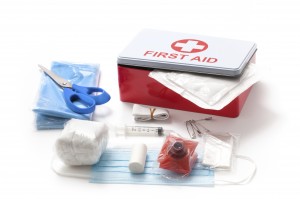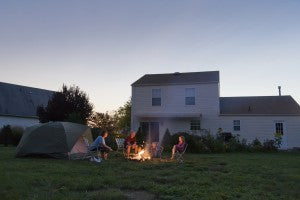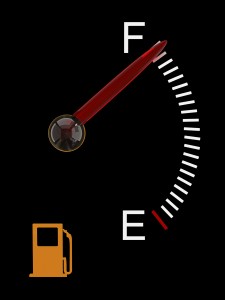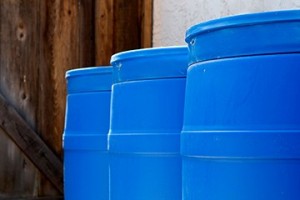In regards to a May 7 story from the Weather Channel web site (weather.com) described “
10 Things You’re Not Doing to Prepare for Natural Disasters,” I conducted a non-random, tiny sample size survey of 11 friends and relatives to see what they were and weren’t doing. Some of them said they felt pretty prepared for an emergency.
I asked 11 questions based on the story from weather.com. The questions and results are at the bottom of this post.
Let’s look at the top six things people weren’t doing.
Do you have a disaster plan for your family?

Only two people surveyed said they have a disaster plan.
“I have a plan if there’s a [house] fire,” one said.
A disaster plan covers what you might face in your area: wildfire, hurricane, or winter storm for example. Where do you meet if some of you are away? Do you shelter at home or evacuate? What are your escape routes? It should answer all those questions.
FEMA has multiple templates for disaster planning including a “
Family Communication Plan" and “
Emergency Financial First Aid Kit.”
Have you set aside a few hundred dollars in small bills?

Seven survey participants had not.
“But we do have an emergency fund in a bank,” one said.
You need cash for about a week, suggested Ann House, coordinator of the Personal Money Management Center at the University of Utah.
“In three days, usually the electricity is back on, the heat is back on and stores are up and going, so if you want to be on the safe side, [keep cash for] a week. The rest can go in the bank,” House said.
Another respondent had cash in larger denominations.
House said that might not work.
“If you were out of water and somebody came by with a water selling wagon, you might be giving the person a $100 bill for water. It’s $1 bills that are going to come in handy for emergencies,” she said.
Have you got a full first aid kit including prescriptions?

Only three participants kept a first aid kit ready with prescriptions.
FEMA’s pamphlet “Preparing Makes Sense for People with Disabilities and Special Needs” recommends keeping enough daily medication for at least a week along with copies of prescriptions and dosage information.
Many insurance providers won’t allow you to get more than a month’s supply of prescription medicines. One survey participant said his family keeps their prescriptions where they can grab them as they’re going out the door. That way they don’t have to get around insurance to obtain extra medicines.
Have you practiced for a disaster?

Five said they had.
One survey respondent said her church congregation hosted a community disaster event a couple of years ago. She didn’t say if she’d practiced since then. FEMA recommends practicing at least twice per year.
Is your car ready for a disaster, including a gas tank at least half full?

Seven said no.
Start by getting a car kit together. It should include emergency supplies, tools, and a change of clothes, according to ready.gov.
Next, make sure the vehicle is in good condition. Then plan where to go and how to get there. Ready.gov provides a
commuter emergency plan where you can fill out alternate routes and modes of transportation.
Most importantly, keep your gas tank at least half-full, Gwen Camp, director of individual and community preparedness for FEMA told weather.com. If you hit gridlock during an emergency and your tank is empty you might not make it to a gas station.
Have you stored at least three gallons of water per person in your family?

Camp told weather.com you should store at least one gallon per person per day for drinking, cooking and sanitation.
FEMA offers information about
how to prepare and store water including bottle types to avoid and how much bleach to sanitize water.
How are you doing in your emergency preparations? In what ways are you not prepared? You can take the survey and see my results below.
Survey:
How many of the following things have you done to prepare for an emergency?
Y N 1. Do you have enough food for your family for three days?
Y N 2. Have you set aside a few hundred dollars in small bills?
Y N 3. Do you have all your important records stored somewhere safe and easy to obtain?
Y N 4. Do you have an out-of-area emergency contact?
Y N 5. Have you stored at least three gallons of water per person in your family?
Y N 6. Do you have a disaster plan for your family?
Y N 7. Do you have a place to stay in an emergency, especially if you have pets? (many places won’t allow them)
Y N 8. Are you trained in CPR and/or first aid?
Y N 9. Have you practiced for a disaster?
Y N 10. Is your car ready for a disaster, including a gas tank at least half full?
Y N 11. Have you got a full first aid kit including prescriptions?
Results:
Table 1:
|
Yes |
No |
Maybe/No answer |
|
| 1. Food for 3 days |
11 |
0 |
|
|
| 2. Savings in small bills |
4 |
7 |
|
|
| 3. Records easily accessible |
8 |
3 |
|
|
| 4. Out-of-area emergency contact |
8 |
3 |
|
|
| 5. Three gallons of water per person |
7 |
4 |
|
|
| 6. Disaster plan |
2 |
7 |
2 |
|
| 7. Emergency shelter |
10 |
1 |
|
"our car" |
| 8. First aid trained |
6 |
3 |
2 |
"not certified" |
| 9. Practiced for a disaster |
5 |
5 |
1 |
"somewhat" |
| 10. Car prepared for disaster |
6 |
5 |
|
|
| 11. First aid kit with prescriptions |
3 |
7 |
1 |
|
Graph 1:

 Only two people surveyed said they have a disaster plan.
“I have a plan if there’s a [house] fire,” one said.
A disaster plan covers what you might face in your area: wildfire, hurricane, or winter storm for example. Where do you meet if some of you are away? Do you shelter at home or evacuate? What are your escape routes? It should answer all those questions.
FEMA has multiple templates for disaster planning including a “Family Communication Plan" and “Emergency Financial First Aid Kit.”
Have you set aside a few hundred dollars in small bills?
Only two people surveyed said they have a disaster plan.
“I have a plan if there’s a [house] fire,” one said.
A disaster plan covers what you might face in your area: wildfire, hurricane, or winter storm for example. Where do you meet if some of you are away? Do you shelter at home or evacuate? What are your escape routes? It should answer all those questions.
FEMA has multiple templates for disaster planning including a “Family Communication Plan" and “Emergency Financial First Aid Kit.”
Have you set aside a few hundred dollars in small bills?
 Seven survey participants had not.
“But we do have an emergency fund in a bank,” one said.
You need cash for about a week, suggested Ann House, coordinator of the Personal Money Management Center at the University of Utah.
“In three days, usually the electricity is back on, the heat is back on and stores are up and going, so if you want to be on the safe side, [keep cash for] a week. The rest can go in the bank,” House said.
Another respondent had cash in larger denominations.
House said that might not work.
“If you were out of water and somebody came by with a water selling wagon, you might be giving the person a $100 bill for water. It’s $1 bills that are going to come in handy for emergencies,” she said.
Have you got a full first aid kit including prescriptions?
Seven survey participants had not.
“But we do have an emergency fund in a bank,” one said.
You need cash for about a week, suggested Ann House, coordinator of the Personal Money Management Center at the University of Utah.
“In three days, usually the electricity is back on, the heat is back on and stores are up and going, so if you want to be on the safe side, [keep cash for] a week. The rest can go in the bank,” House said.
Another respondent had cash in larger denominations.
House said that might not work.
“If you were out of water and somebody came by with a water selling wagon, you might be giving the person a $100 bill for water. It’s $1 bills that are going to come in handy for emergencies,” she said.
Have you got a full first aid kit including prescriptions?
 Only three participants kept a first aid kit ready with prescriptions.
FEMA’s pamphlet “Preparing Makes Sense for People with Disabilities and Special Needs” recommends keeping enough daily medication for at least a week along with copies of prescriptions and dosage information.
Many insurance providers won’t allow you to get more than a month’s supply of prescription medicines. One survey participant said his family keeps their prescriptions where they can grab them as they’re going out the door. That way they don’t have to get around insurance to obtain extra medicines.
Have you practiced for a disaster?
Only three participants kept a first aid kit ready with prescriptions.
FEMA’s pamphlet “Preparing Makes Sense for People with Disabilities and Special Needs” recommends keeping enough daily medication for at least a week along with copies of prescriptions and dosage information.
Many insurance providers won’t allow you to get more than a month’s supply of prescription medicines. One survey participant said his family keeps their prescriptions where they can grab them as they’re going out the door. That way they don’t have to get around insurance to obtain extra medicines.
Have you practiced for a disaster?
 Five said they had.
One survey respondent said her church congregation hosted a community disaster event a couple of years ago. She didn’t say if she’d practiced since then. FEMA recommends practicing at least twice per year.
Is your car ready for a disaster, including a gas tank at least half full?
Five said they had.
One survey respondent said her church congregation hosted a community disaster event a couple of years ago. She didn’t say if she’d practiced since then. FEMA recommends practicing at least twice per year.
Is your car ready for a disaster, including a gas tank at least half full?
 Seven said no.
Start by getting a car kit together. It should include emergency supplies, tools, and a change of clothes, according to ready.gov.
Next, make sure the vehicle is in good condition. Then plan where to go and how to get there. Ready.gov provides a commuter emergency plan where you can fill out alternate routes and modes of transportation.
Most importantly, keep your gas tank at least half-full, Gwen Camp, director of individual and community preparedness for FEMA told weather.com. If you hit gridlock during an emergency and your tank is empty you might not make it to a gas station.
Have you stored at least three gallons of water per person in your family?
Seven said no.
Start by getting a car kit together. It should include emergency supplies, tools, and a change of clothes, according to ready.gov.
Next, make sure the vehicle is in good condition. Then plan where to go and how to get there. Ready.gov provides a commuter emergency plan where you can fill out alternate routes and modes of transportation.
Most importantly, keep your gas tank at least half-full, Gwen Camp, director of individual and community preparedness for FEMA told weather.com. If you hit gridlock during an emergency and your tank is empty you might not make it to a gas station.
Have you stored at least three gallons of water per person in your family?
 Camp told weather.com you should store at least one gallon per person per day for drinking, cooking and sanitation.
FEMA offers information about how to prepare and store water including bottle types to avoid and how much bleach to sanitize water.
How are you doing in your emergency preparations? In what ways are you not prepared? You can take the survey and see my results below.
Survey:
How many of the following things have you done to prepare for an emergency?
Y N 1. Do you have enough food for your family for three days?
Y N 2. Have you set aside a few hundred dollars in small bills?
Y N 3. Do you have all your important records stored somewhere safe and easy to obtain?
Y N 4. Do you have an out-of-area emergency contact?
Y N 5. Have you stored at least three gallons of water per person in your family?
Y N 6. Do you have a disaster plan for your family?
Y N 7. Do you have a place to stay in an emergency, especially if you have pets? (many places won’t allow them)
Y N 8. Are you trained in CPR and/or first aid?
Y N 9. Have you practiced for a disaster?
Y N 10. Is your car ready for a disaster, including a gas tank at least half full?
Y N 11. Have you got a full first aid kit including prescriptions?
Results:
Table 1:
Camp told weather.com you should store at least one gallon per person per day for drinking, cooking and sanitation.
FEMA offers information about how to prepare and store water including bottle types to avoid and how much bleach to sanitize water.
How are you doing in your emergency preparations? In what ways are you not prepared? You can take the survey and see my results below.
Survey:
How many of the following things have you done to prepare for an emergency?
Y N 1. Do you have enough food for your family for three days?
Y N 2. Have you set aside a few hundred dollars in small bills?
Y N 3. Do you have all your important records stored somewhere safe and easy to obtain?
Y N 4. Do you have an out-of-area emergency contact?
Y N 5. Have you stored at least three gallons of water per person in your family?
Y N 6. Do you have a disaster plan for your family?
Y N 7. Do you have a place to stay in an emergency, especially if you have pets? (many places won’t allow them)
Y N 8. Are you trained in CPR and/or first aid?
Y N 9. Have you practiced for a disaster?
Y N 10. Is your car ready for a disaster, including a gas tank at least half full?
Y N 11. Have you got a full first aid kit including prescriptions?
Results:
Table 1:



4 comments
Joanne McNulty
Put a wire cutter in your car trunk…all interstates are edged with wire and you cannot walk/drive off anywhere you might want/have to when there is gridlock.
Linda Sand
So many of us live our lives on computers nowadays I would add portable, preferably offsite, computer backup of important documents and data. I keep a thumb drive in my pocket so I have my data wherever I am; at night it sits on a bedside table ready to grab in an emergency.
Frank Sorrenti Sr.
Thanks for all your work…
kelly
I was surprised to realize that I wasn’t as prepped as I thought. Although we are working on it. We were better prepped when the kids were living at home. Several of the questions were “sort of” rather than yes or no. We have a plan but it is very outdated. It is my New Years resolution…I am working on it and it will be ready by end of New Years Day. My husband is really good about keeping his vehicle 3/4 or more full…I am lousy at even 1/2 for mine, which is very bad as it is the primary bug out vehicle. Each bug out bag has about $20 in ones and change, plus a few Kennedy halves with the silver. But not hundreds. I have taken and been certified for first aid and CPR, but not recently. Used to do it every 5 years, but it has been at least 8. I can see exactly what my resolutions will be for Jan. The only other one is the documents. Can I say Yes and No? They are all together, and I have photo copies that are easy to get to, but the originals (though altogether) are not easily accessible. Maybe some ideas for how to do that, without leaving them vulnerable to damage, theft, or other disasters would be a great idea for an upcoming article. Thank-you! I love these little surveys; they are very illuminating!